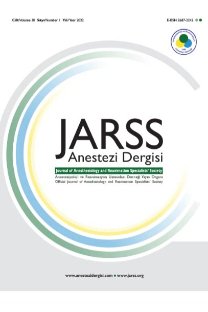Kardiyopulmoner bypass uygulanan koroner arter hastalarında desfluran anestezisinin karaciğer fonksiyonlarına etkisi
Glutatyon transferaz, Kardiyopulmoner bypass, Karaciğer fonksiyon testleri, Anestezikler, inhalasyon
The effect of desflurane on hepatic function in patients undergoing cardiopulmonary bypass
Glutathione Transferase, Cardiopulmonary Bypass, Liver Function Tests, Anesthetics, Inhalation,
___
- 1. Eger El. The clinical use of desflurane. Yale J Biol Med 1993; 66(5): 491-500.
- 2. Tiainen P, Rosenberg PH. Hepatocellular integrity during after isoflurane and halathone anaesthesia in surgical patients. Br J Anaesth 1996;77:744-7.
- 3. D. C. Ray, G. J. Beckett, and L. G. Allan. Hepatocellular integrity after inhalation anaesthesia. Br J Anaesth 1997; 78: 772-3.
- 4. Tiainen P, Lindgren L, Rosenberg PH et al. Changes in hepatocelluler integrity during and after Desflurane an İsoflurane anaesthesia in patients undergoing breast surgery. Br J Anaesth 1998; 80: 87-9.
- 5. Tiaivainien T, Tianen P, Meretaja O. Comparison of the effects of sevoflurane and halothane on the quality of anaesthesia and serum aGST and fluoride in pediatric patients . Br J Anaesth 1994; 73: 590-5.
- 6. Eğer EL New inhaled anesthetics. Anesthesiology 1994 Apr; 80(4): 906-22.
- 7. Mets B. Reich N.T., Mellas N., Beek J., Park S. Desflurane pharmacokinetics during CPB. J Cardiothorac Vasc Anesth. 2001;15:179-82.
- 8. Beckett GJ, Hoyes JD. Glutathione S-Transferases: Biomedical applications. Adv Clin Chem. 1993;30: 281-9.
- 9. Thea PJ, Mulder G, Daniel A. Count and Wilbert HM et al. Variability of aGST in human liver and plasma. Clin Chem 1999;45:355-9.
- 10. Cahalan MK, Weiskopf RB, Eğer El et al. Hemodynamic effects of Desflurane /N2O Anaesthesia İnvolunters Anaesthesia 1998; 47:980-5.
- 11. Merin RG, Bernard JM, Doursout MF, Cohen M. Comparison of the effects of isoflurane and desflurane on cardiovascuiar dynamics and regional blood flow m the chronıcally ınstrumented dog. Anesthesiology 1991; 73: 157-64
- 12. Martin J, Jackie L, Plewak B et al. Hepatotoxicity after Desflurane anesthesia. Anesthesiology 1995;83:1125-9.
- 13. Koblin DD. Characteristics implications of desflurane metabolism and toxicity. Anesth Analg 1992;75:10-6.
- 14. Kenna JG, Jones RM. The organ toxicity of inhaled anesthetics. Anesth Analg 1995;81:51-66.
- 15. Desai JB, Mathie RT, Taylor KM. Hepattc blood flow during cardıopulmonary bypass in the dog :a comparison between pulsatile and non pulsatile perfusion. Life supp systems 1984; 2:303-5
- 16. Less MH, Herr RH, Hill JD et al. Distribution of systemic blood flow during CPB. Thorac Cardiovasc Surg 1971; 61: 570-86.
- 17. Rudy LW Jr, Heymann MA, Edmunds LH Jr.Distribution of systemic blood flow during CPB. J Appl Physiol 1973; 34: 194-200.
- 18. Sicsic JC, Duranteau J, Corbineau H et al. Gastric mucosal oxygen delivery decreases during CPB despite constant systemic oxygen delivery. Anesth Analg 1998;86:455-60.
- 19. Wang MJ, Chao A, Huang CH et al. Hyperbilirubinemia after cardiac operation. Incidence, risk factors, and clinical significance. J Cardiovasc Surg 1994 ; 108:429-36.
- 20. Hussey AJ, Aldridge LM. Plasma aGST concentration as a measure of hepatocellüler integrity following a single general anesthetic with halothane, enflurane or isoflurane. Br J Anaesth. 1988; 60:130-5.
- 21. Hussey AJ, Howie LG. Impaired hepatocellüler integrity during general anaesthesia, as assessed by measurement of aGST. Clin Chimica Acta 1986; 161:19-28.
- ISSN: 1300-0578
- Yayın Aralığı: 4
- Başlangıç: 1993
- Yayıncı: Betül Kartal
DİDEM DAL, M. Alper SALMAN, A. Ebru SALMAN, Alper B. İSKİT, Ülkü AYPAR
İsmailov Niyazali VAHİTOVİÇ, İbrahim AŞIK, Serkan ENÖN, Zekeriya ALANOĞLU, Bahattin DURU, Mehmet ORAL, Sacide DEMİRALP, Filiz TÜZÜNER, Hadi AKAY
Pektus ekskavatum cerrahisinde genel anestezi ve epidural analjezi kombinasyonu(Olgu sunumu)
Çimen G. OLGUNER, Hakan KİLERCİK, Nagehan DAMAR, Sevda ÖZKARDEŞLER, Pelin KARTAL, Feza AKGÜR, Zahide ELAR
Galaktozemili hastada anestezik yaklaşım (Olgu sunumu)
DİDEM DAL, Aydın ERDEN, Ahmet GÖZAÇAN, Turgay ÖCAL
HELLP sendromu olgularında antitrombin III (AT-III) uygulaması (Olgu sunumu)
Selda ŞEN, Galip ÖZMERT, Eray ÇALIŞKAN, Berna DİLBAZ, Güzel DİŞÇİGİL
Sevofluran anestezisi altında torakal epidural analjezi uygulamasının stres yanıt üzerine etkisi
Çetin KAYMAK, Aytül Ş. KILINÇ, Turgut ÇAVUŞOĞLU, Filiz TÜMER, Fırat UNCUGİL, Ferah DÖNMEZ, Lale KARABIYIK
Murat DEMİREL, Füsun GÜZELMERİÇ, Rezan YALTIRIK, Fahriye GÜLER, Halide OĞUŞ, Haluk KARACA, Tuncer KOÇAK
Timektomi uygulanan miyastenia gravis'li olguda laringeal maske (Olgu sunumu)
Ahmet BİLEN, Dalokay KILIÇ, Suat Özer ÖNER, Nusa TUNA, Ayda TÜRKÖZ
Ahmet KÖROĞLU, ENDER GEDİK, NURÇİN GÜLHAŞ, Hüseyin İ. TOPRAK, Kazım KARAASLAN, M. Özcan ERSOY
Nurten KAYACAN, Bilge KARSLI, AYŞE GÜLBİN ARICI, Zekiye BİGAT, Meliha ERMAN
